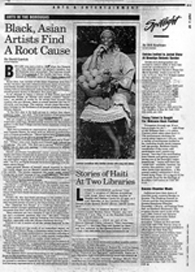
From Artspiral Magazine Issue #1
New
York Newsday
Tuesday, May 2, 1995
"Arts in the Boroughs"
by David
Garrick, Staff Writer
Bob Lee was just a kid in 1968 when the Newark race riots erupted near his father's laundry, but the business went untouched. The business would have been targeted if the family had been white, instead of Chinese, some of the black rioters told them.
Since then, Lee, curator of the Asian American Arts Centre for 16 years, has seen relations between Asian-Americans and Blacks steadily deteriorate in the New York area, culminating with an extended and violent Black boycott of Korean-owned grocery stores in Brooklyn five years ago.
In an attempt to begin a reverse of that trend, Lee and Kenkelaba House, an African, Asian or mixed between the two in ethnicity and heritage. The exhibit, which closes Saturday, pays homage to the forebears of all people of either Asian or African descent.
"A big first step is for both groups to realize they share common roots," Lee said. "The long history of harmony this art represents makes contemporary racism seem silly."
The Art ranges in size from large wooden altars to small watercolor paintings, divided evenly between Kenkelaba gallery in the East Village and the Asian American Centre in Chinatown.
"Bob is creating an unprecedented, dynamic situation," Yoland Skeete, an artist with an African grandmother and a Chinese grandfather. "Never before have Chinese held their hands out to an African grout like this."
Skeete, in her mid-40s and from Newark, grew up in Trinidad. "When I was a kid, blacks and Chinese both refused to accept me," she said. "But Bob Lee is saying, ‘You're a half-breed but we love you anyway.' I wish everyone in society would say that."
Skeete attributes heightened racial tension between blacks and Asian Americans to economics as much as racism. "If this country would let us all prosper with fairer economy and higher wages, there would be no race problem," she said. "As it is, we battle because we're both fighting over the same scarce things."
Laser-printed photos of herself, pieced together to form her bodily shape, are on Skeete's candle-decorated altar in the exhibit. The photos represent the racial mask society forces her to wear because of her mixed ethnicity, she said, and the altar is a method of worship Asian and African cultures share, that Europeans do not.
Howardena Pindell, an artist from Westchester, considers "Ancestors" a refreshing change from a usually very segregated art world. "I learned so much from this exhibit and felt such kinship with the other artists because I realized many others have faced the same impediments in life and art as I have."
Pindell, 52, who has three paintings in the exhibit, is an art professor at the State University at Stony Brook and the only tenured person of color in her department, she said.
Her "separate but equal" is a scathing indictment of South Africa's former apartheid government and other governments that don't strive hard enough for racial equality."
Race relations are very complex in the U. S. and if Clinton isn't re-elected, tensions may rise," she said. "Things like this exhibit really with the African ancestral dancing."
Politics is not a motive of all the artists featured in the exhibit.
"I don't think art has much of an immediate impact on politics," said Elaine Wong, a Jamaican artist living in Boston, who has two large water colors in the exhibit, including a self-portrait. "It would be hard to make society realize that 'the melting pot' is a myth no matter what I painted."
Saturday's closing ceremony will include a performance of "Dance of the Egungun," a masquerade worshiping ancestor spirits of the Yoruba tribe of Nigeria. As part of the tradition, the dancers – one of whose work is featured in the exhibit – will be unidentified.
"The dancers don't reveal themselves so the audience can focus on the ancestors they represent," Lee said.
Both Kenkelaba House and Asian American Arts Centre intend to continue research on this show and the ancestral harmony represented in it, and will seek additional funding to sustain this effort.
A symposium on these issues and another possible exhibit are planned for later this year. Kenkelaba House is at 214 E. Second St. and the Asian American Arts Centre is at 26 Bowery near Canal St. The "Dance of the Egungun" performance begins at 4 p.m. Saturday. Call (212) 233-2154 for more information.
To read Joan Kee's response to David Garrick's article, click here.
[ close window ]